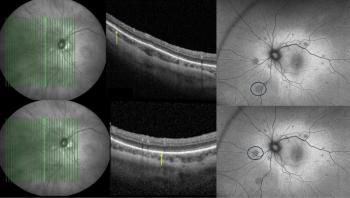
AAO 2024: Approaching pregnant women across the ophthalmic subspecialties
Dr. Arepalli discussed a course focused on ocular conditions related to pregnancy and postpartum care, presented at the American Academy of Ophthalmology (AAO) meeting.
In a recent discussion with Dr. Arepalli and Sydney Crago from Modern Retina and Ophthalmology Times discussed a course focused on ocular conditions related to pregnancy and postpartum care, presented at the American Academy of Ophthalmology (AAO) meeting. Dr. Arepalli emphasized the need for better understanding and treatment protocols for conditions affecting pregnant patients, particularly in the fields of retina and uveitis.
Editor's note: This transcript has been lightly edited for clarity.
Sydney M. Crago: Hi, I'm Sydney Crago with Modern Retina and Ophthalmology Times, and I'm here today with Dr. Arepalli to talk a little bit about her course at AAO this year. Dr Arepalli, could you share what this course will entail?
Sruthi Arepalli, MD: Yes, thank you so much for having me. So this course is basically looking at conditions that are specific to pregnancy or postpartum and examining those conditions and how they can worsen or be treated during pregnancy. I put this course together for the AAO because, as I started my career in retina and uveitis, I realized that there are quite a few conditions that we don't have a great algorithm for if you're pregnant, and there's lots of good reasons for that. It's because we don't want to do undue harm to the fetus or to the mother or risk pregnancy. But at the same time, it raises the question of what we should be doing and how we can prevent further vision loss. And then I started digging a little bit deeper, and I realized that these conditions, while in retina and uveitis, they also exist in other subspecialties as well. So I looped in some of my good colleagues across different subspecialties, including neuroophthalmology, oncology, cornea, retina, uveitis, and glaucoma, to speak about some of the common conditions and how we approach them in these patients.
Sydney M. Crago: As we talk about some of the common conditions, what are ones that you in particular work with?
Sruthi Arepalli, MD:That's a great question. In retina and uveitis, I feel like we see a lot, and we see a lot of conditions that rely on dye testing or intravitreal agents. So one of the biggest things that we see is diabetic retinopathy in the retina clinic, and that's a huge condition. It has a lot of complications that can follow if it's untreated. If you have diabetic macular edema that sits for a long time, you worry that you'll have long, lasting vision loss. But the problem is that the traditional treatment for these patients are anti0VEGF factors, so they're injections into the eye, and there is not good data on what that looks like for fetus or for pregnancy, and what that looks like for breastfeeding. Some of the other things that I treat are in the uveitis realm. So I see a lot of posterior uveitis, and that's heavily reliant on imaging like fluorescein angiography and ICG, and those are topics we touch upon as well: what's safe during pregnancy, what you can advise for when a patient's breastfeeding? One of the other things that I thought was so interesting is retina surgery. So if a patient comes in with a retinal detachment, you know you don't want to delay care, but I've always found that when I have a pregnant patient with a retinal detachment or someone who needs a retinal intervention, it's a very complex discussion between them, their OB/GYN, anesthesia, and myself, and so I think it'd be really nice to bring that to the table as well, because all the subspecialists who are attending likely have to take patients to surgery as well.
Sydney M. Crago: Just out of curiosity, does gestational diabetes play a role in any of these diabetic conditions?
Sruthi Arepalli, MD: Yes. So gestational diabetes can manifest when you're pregnant, and you can be at higher risk based on certain risk factors, and that can be also really hard for a patient, right? Because they're pregnant, they're already caring for this patient, but also their newborn child or expecting child, but at the same time, you're giving them a new diagnosis of diabetes, and then you're also discussing vision loss. And so if they haven't dealt with it before, or they're suddenly losing vision, it's very scary to tell them that we're going to sit on it or what our limited options are. And so I think it's, it's an important topic to discuss and to have a really good armamentarium of treatment options.
Sydney M. Crago: Fascinating. Anything else you'd like to share about this course or AAO in general?
Sruthi Arepalli, MD: Well, I just think AAO is such a wonderful meeting. We have so many experts in the field that come together for a little over a weekend, and they get to share all their pearls. I'm hoping that anyone who attends this course finds that we have similar pearls to share with them as well.
Newsletter
Get the essential updates shaping the future of pharma manufacturing and compliance—subscribe today to Pharmaceutical Technology and never miss a breakthrough.













































